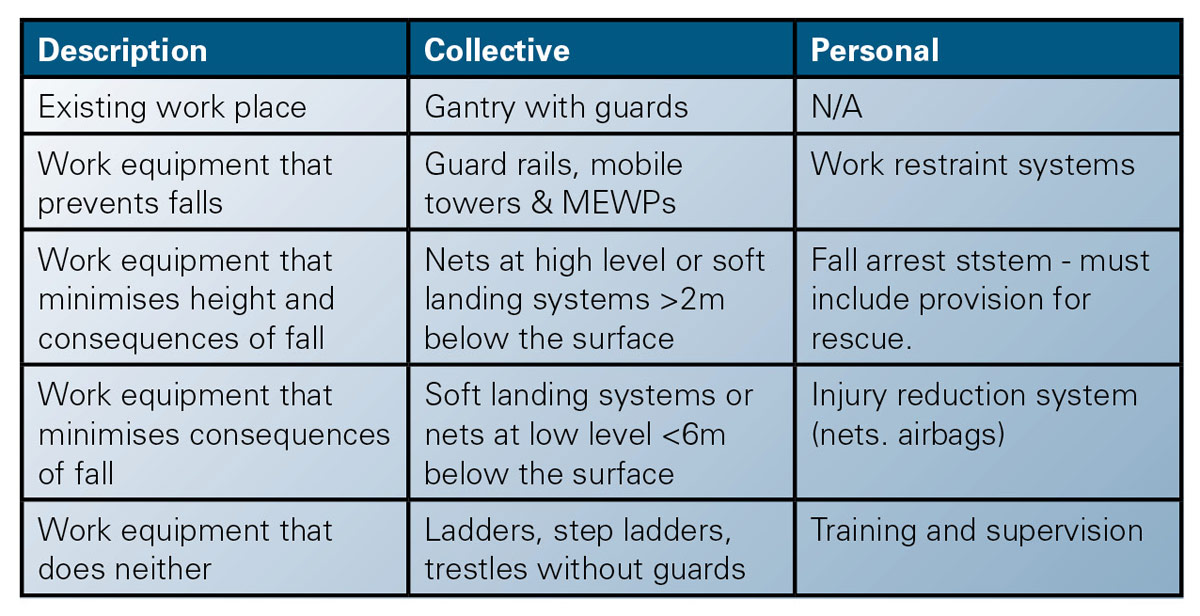Projects and Features
Safe working at height in the steelwork industry
New regulations for working at height outline principles for choosing a “reasonably practicable” solution and set out a hierarchy of fall prevention measures, reports BCSA Health and Safety Manager Peter Walker.
Working at height is a known and necessary part of steel erection work. Great strides have been made in recent years in improving safety systems. Compared with the situation 10 years ago, simple to erect and effective edge protection systems have been introduced, mobile working platforms have almost superseded ladders and work restraint systems have been improved.
New regulations on work at height came into force on 6 April 2005. They place duties on employers, the self-employed, and anyone who controls the work of others (for example facilities managers or building owners who may contract others to work at height).
The effect of the new regs is mainly to consolidate existing regulations, but their scope has been widened to embrace industry in general, rather than being primarily aimed at the construction industry.
The regulations apply to all work at height where there is a risk of a fall liable to cause personal injury. They do not apply to the provision of instruction or leadership in caving or climbing by way of sport, recreation, team-building or similar activities.
Under the regulations, duty holders are required to ensure that:
- all work at height is properly planned and organised;
- those involved are competent;
- the risks from the work are assessed and appropriate work equipment is selected and used;
- the risks from fragile surfaces are properly controlled; and
- equipment is properly inspected and maintained.
The regulations include schedules giving requirements for existing places of work and means of access for work at height, collective fall prevention (such as guardrails and working platforms), collective fall arrest (such as nets, airbags and so on), personal fall protection (work restraints, fall arrest and rope access) and ladders.
Hierarchy of Fall Prevention/Protection Measures
Table 1 can be used as a guide to selecting the appropriate protection for working at height. It represents a hierarchy, starting at the top left corner with the most desirable option and working down to the bottom right corner as the least desirable option. You may use whatever system represents a “reasonably practicable” solution to your working needs, but if you select one of the systems lower down the hierarchy, you must be able to demonstrate why you could not use the more desirable solutions. Collective protection is preferred over personal protection.
Risk Assessment
All workplace activities need to have a risk assessment carried out prior to the work commencing. Although in most cases well-established safe systems of work can be employed, unusual or exceptional circumstances may always arise that mean that risk assessments have to be developed to minimise the distance and a consequence of a fall.
Assessment of Residual Risks
You should avoid putting more people at personal risk while installing and dismantling fall protection measures, especially if the actual work is expected to be of short duration and can be carried out with less risk than the work required to install the protective measures. For example installing scaffolding around a trailer to unload it could put two people at considerable risk for a longer period than it would to put a person on a restraint system to complete the loading/unloading work. Similarly installing a net under a cantilever to install decking panels could put the net installers at greater risk, when the decking panels could be installed using a work restraint system. The message is really to look at the bigger picture of all the associated activities before deciding what action to take, rather than putting more and more trades at risk.
Remember there is no one solution that satisfies all activities: that is why there should be a risk assessment of each activity and duty holders should be “reasonably practicable” in their approach to managing the identified risks.
The Work at Height Regulations 2005 consolidate previous legislation on working at height and will implement European Council Directive 2001/45/EC concerning minimum safety and health requirements for the use of equipment for work at height (the Temporary Work at Height Directive or TWAHD).














